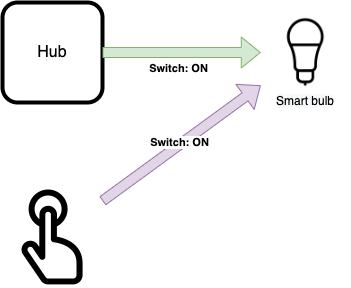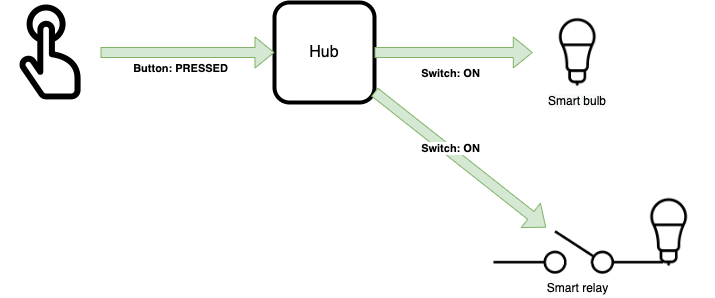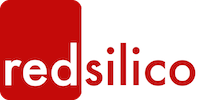In this the second article in my mini Zigbee compatibility series, I thought I would cover the specific topic of the different types of lighting controls.
Zigbee lighting controls
If you're already bitten by the smart home bug, you may have observed that some types of device tend to be more compatible than others, and some companies' products are more interoperable than others. By and large, thanks to some evolution of the ZigBee protocol and efforts by manufacturers to adopt the standards, zigbee bulbs tend to be largely interchangeable these days (though see vendor idiosyncracies in my previous article). Controls for those bulbs are a different matter. You can use Innr, Tradfri, Osram bulbs etc on a Hue hub, but can't use these companies' various dimmer controls. They're all zigbee standard devices, so why is this?
One of the main reasons is because of how these manufacturers have chosen to implement ZigBee in their products.
IKEA Tradfri
The Tradfri system is quite a "pure" ZigBee implementation. The devices communicate like this:

The "steering devices" as IKEA calls them send zigbee on/off/dim/colour change commands 'directly' to bulbs etc over the zigbee mesh; they dont need to go via the hub. These control devices are configured automatically using standard ZigBee features like groups.
The way you add a bulb to theTradfri system is:
- Add the "steering device" to the Zigbee gateway's mesh network. When it joins the network, it lives in its own "group" which the app presents to users as a "room".
- Use the steering device to add the bulb to the mesh using the ZigBee "touchlink" procedure.
- Users can (optionally) move a steering device to the same group (room) as another device
Most of this is done between the devices themselves, you dont actually need the app to join new bulbs; the app just shows you the instructions and sets the hub into pairing mode, and asks the hub about new devices it has found.
This design is influenced by a few factors: the built-in touchlink process requires that two devices are next to each other. It wouldn't work if you had to bring the ethernet-connected gateway and a FLOALT ceiling panel in close proximity, but bringing a remote control to the light works. The system is also designed to work without any "app" or "hub": you only need these if you want them. This is a smart move on IKEA's part as consumers are sensitive to whether they need to buy another hub when choosing smart home products. This is why steering devices are mandatory!
The product itself is also intended to be more simple than other solutions: IKEA doesnt aim to provide a smart home automation platform and they don't need their buttons to be capable of triggering other non-zigbee devices. They just need them to work with other IKEA ZigBee products and to do so without any complicated configuration. If they ever choose to change this, they can always move to a model like Hue's (see below).
Osram/Sylvania/Ledvance/SMART+/Lightify
I won't go into the confusing mess of branding this ecosystem suffers from but will outline how it works. Suffice to say it's broadly the same as Tradfri: it can work without a hub because all of the communications between dimming switches and bulbs is direct through the zigbee mesh, and adding a hub just provides an additional way to control them from an app, automation platform etc.
However, the way you configure the behaviour of dimming controls when using a Hub is different: it's more flexible but, crucually, is managed by the Lightify gateway and is not a built-in capabiity that you can initiate from the switches themselves like you can with Tradfri. The way you do this is:
- Add the dimming switch to the gateway.
- By default, the switch is configured to broadcast on/off/dim/colour controls to all devices in the mesh. This is different from Tradfri.
- You can use the app to tell the gateway to reconfigure the behaviour of each button on the switch, e.g. to send commands only to a group of bulbs. This is different from Tradfri.
What this means is that, because other manufacturers' hubs dont work that way, unless you are happy with the default behaviour of switches to on/off/dim every bulb in the mesh, you need the lightify hub. Tradfri devices on the other hand can be linked to specific bulbs regardless of what kind of hub they're connected to.
Hue
The Hue system works in one of two ways. Without a hub:

OR with a hub:

Notice that the dimmer switch buttons can work on two different ways.
In the Hue ecosystem, the hub is where all of the configuration is made: the hub is the component that apps and other smart home platforms like HomeKit, SmartThings and IFTTT interact with. This influences how Hue design their products:
- Hue does not have any "smart switches", because this goes against their USP of "colour" (it's even in the name...): they want to sell lots of expensive bulbs.
- Hue's lighting controls work entirely through the hub: it's the hub that tells the bulbs what to do, the switches are just triggers. This allows you to define complex rules to control what the buttons and other sensors do (e.g. different things at different times).
- The app will only provide the ability to configure their own switches. Switches that send messages directly to the bulbs will work, but you can't involve them in those rules and can't change their behaviour via the Hue app or hub.
Compaibility Matrix
| Hue hub | Tradfri gateway | SmartThings Hub | Lightify gateway | |
|---|---|---|---|---|
| Bulbs | Yes | Yes | Yes | Yes |
| Hue sensors | Yes | No | Yes | No |
| SmartThings button | No | No | Yes | No |
| Tradfri controls |
Yes (not visible in app) |
Yes | Yes | Yes |
| Lightify/SMART+ switches |
No (controls all devices) |
No |
Possible (with custom handler) |
Yes |

Thanks a bunch for launching